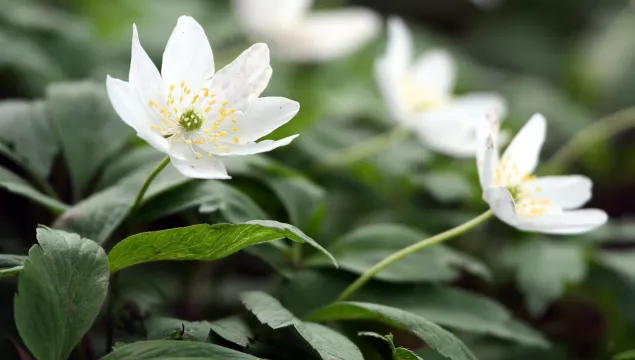Columbine
The bonnet-shaped, violet-blue flowers of Columbine can be spotted in damp areas in woodlands and in fens. It is also an attractive and much-loved garden plant.
The bonnet-shaped, violet-blue flowers of Columbine can be spotted in damp areas in woodlands and in fens. It is also an attractive and much-loved garden plant.
The fluffy, white seed heads of Traveller's-joy give it the evocative, alternative names of 'Old Man's Beard' and 'Father Christmas'. A clematis-like climber, it can be seen scrabbling over hedgerows and in woods.

A spring delight, the wood anemone grows in dappled shade in ancient woodlands. Traditional management, such as coppicing, can help such flowers by opening up the woodland floor to sunlight.
The pretty-in-purple Pasqueflower is now a rare plant in the UK, restricted to just a few chalk and limestone grasslands. Steeped in legend, it flowers at Easter, so is known as the 'anemone of Passiontide'.
Once considered a weed of cornfields, the Common poppy is now in decline due to intensive agricultural practices. It can be found in seeded areas, on roadside verges and waste ground, and in field margins.
The Welsh poppy is a plant of damp and shady places, roadsides and hillsides. It is also a garden escapee. It flowers over summer, attracting nectar-loving insects.
Easily recognised in its beach habitat, the Yellow horned-poppy is so-named for its long, curving seedpods that look like horns! Look for golden-yellow flowers in June.
Greater celandine is a very common plant that spreads easily in the garden, on waste ground and in hedgerows. It is considered a weed, but the small, yellow flowers provide nectar for insects.
Look for the Yellow water-lily in still and slow-moving water, such as ponds, ditches, lakes and canals. Its lily pads and cupped, yellow flowers float at the water's surface.
Look for the White water-lily in still and slow-moving water, such as ponds, ditches, lakes and canals. Its lily pads and massive, white flowers float at the water's surface.
A scrambling 'weed' of waste ground, fields and gardens, Common fumitory can be found on dry and disturbed soils. Its pink flowers appear over spring and summer.
Yellow corydalis is a familiar 'weed' of gardens, walls and rocky places. It is a garden escapee in the UK, so is not a native plant. Try choosing natives for your garden to prevent species escaping into the wild.